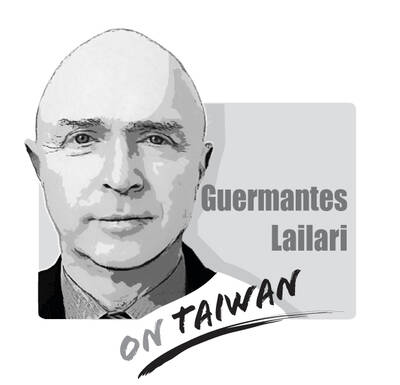A few days ago, a hospital system in northern Taiwan said hackers from the Crazy Hunter ransomware group attacked their patient data systems, not only taking more than 500 computers offline, but also stealing 16.6 million documents containing personal data. Afterward, the hackers peddled the data to a criminal ring for US$100,000.
Government agencies immediately demanded that hospitals boost their internal control mechanisms. They also reminded the public to be aware of possibly leaked personal information and urged all sectors to bolster data security and protections.
IT security is not just a matter of corporate responsibility, but concerns the public’s privacy as well, touching upon network security and data maintenance for vital public utilities and services. If we fail to respond properly, the problem could metastasize into a major breach of national security, turning into an invisible imminent threat.
A few days ago, the Association of Chinese Police Research convened a seminar to discuss the governance models the Australian government uses for handling fraud and network security. Network security governance was specifically brought up in the seminar. It is not just an important means of fighting fraud — it is a cornerstone of protections at the national security level.
Studies suggest that North Korea is a source of some ransomware used in attacks on large companies where embedded software siphoned off data, then throttled company computer systems to a halt.
Taiwanese corporations have increased their defenses and established more refined contingencies to fend off network attacks, and system throttling and paralysis. However, during the theft of US$1.5 billion of etherium on the Bybit cryptocurrency exchange platform during a routine transfer, Bybit’s multisignature mechanisms were infiltrated through social engineering. The hackers directly stole digital assets and continue to sell stolen private data to criminal rings.
However, cybercriminals have begun shifting away from that pattern of infiltration. Academics are proposing that the thinking behind crime policy no longer be solely centered on avoiding system paralysis, not paying ransoms or reminding the public to be aware of malicious software — the truth is that we must all pay attention to changes and trends in tech crime at all times.
To tackle online crime, Canberra established the Australian Criminal Intelligence Commission, as well as the Australian Cyber Security Centre, and online reporting and case systems.
In the past, the Australian government classified frequently targeted victims of criminal groups into four tiers: government and related agencies; large transnational corporations; small and medium-sized businesses; and individuals. That has been simplified by combining the two business categories. Australia on Feb. 13 passed the world’s first innovative proactive prevention law, the Scams Prevention Framework. The framework made it mandatory for measures to be enforced in industries with high concentrations of fraudulent activity. It also includes codified comprehensive laws and regulations that businesses must follow.
To effectively fight against fraud, Australia temporarily put aside its anti-fraud task force and authorized the Australian Competition and Consumer Commission to act as the lead body with the primary responsibility of directing anti-fraud activities. Since the commission closely monitors whether regulated entities are complying with the prevention, detection, deterrence, response and documentation of fraud, it could hopefully clamp down on invisible imminent threats. The framework’s further development is worth the attention of government agencies and corporations.
Samuel Lin is an assistant professor at the Central Police University.
Translated by Tim Smith

“History does not repeat itself, but it rhymes” (attributed to Mark Twain). The USSR was the international bully during the Cold War as it sought to make the world safe for Soviet-style Communism. China is now the global bully as it applies economic power and invests in Mao’s (毛澤東) magic weapons (the People’s Liberation Army [PLA], the United Front Work Department, and the Chinese Communist Party [CCP]) to achieve world domination. Freedom-loving countries must respond to the People’s Republic of China (PRC), especially in the Indo-Pacific (IP), as resolutely as they did against the USSR. In 1954, the US and its allies
A response to my article (“Invite ‘will-bes,’ not has-beens,” Aug. 12, page 8) mischaracterizes my arguments, as well as a speech by former British prime minister Boris Johnson at the Ketagalan Forum in Taipei early last month. Tseng Yueh-ying (曾月英) in the response (“A misreading of Johnson’s speech,” Aug. 24, page 8) does not dispute that Johnson referred repeatedly to Taiwan as “a segment of the Chinese population,” but asserts that the phrase challenged Beijing by questioning whether parts of “the Chinese population” could be “differently Chinese.” This is essentially a confirmation of Beijing’s “one country, two systems” formulation, which says that
On Monday last week, American Institute in Taiwan (AIT) Director Raymond Greene met with Chinese Nationalist Party (KMT) lawmakers to discuss Taiwan-US defense cooperation, on the heels of a separate meeting the previous week with Minister of National Defense Minister Wellington Koo (顧立雄). Departing from the usual convention of not advertising interactions with senior national security officials, the AIT posted photos of both meetings on Facebook, seemingly putting the ruling and opposition parties on public notice to obtain bipartisan support for Taiwan’s defense budget and other initiatives. Over the past year, increasing Taiwan’s defense budget has been a sore spot
Media said that several pan-blue figures — among them former Chinese Nationalist Party (KMT) chairwoman Hung Hsiu-chu (洪秀柱), former KMT legislator Lee De-wei (李德維), former KMT Central Committee member Vincent Hsu (徐正文), New Party Chairman Wu Cheng-tien (吳成典), former New Party legislator Chou chuan (周荃) and New Party Deputy Secretary-General You Chih-pin (游智彬) — yesterday attended the Chinese Communist Party’s (CCP) military parade commemorating the 80th anniversary of the end of World War II. China’s Xinhua news agency reported that foreign leaders were present alongside Chinese President Xi Jinping (習近平), such as Russian President Vladimir Putin, North Korean leader Kim